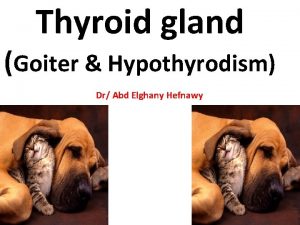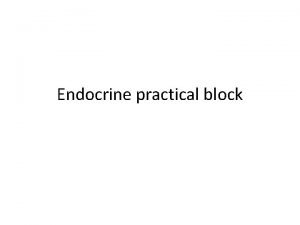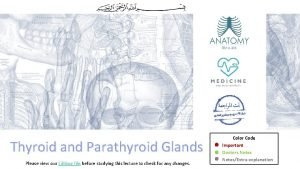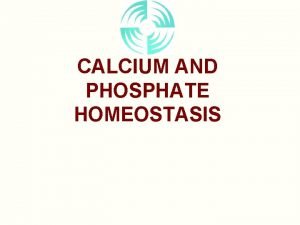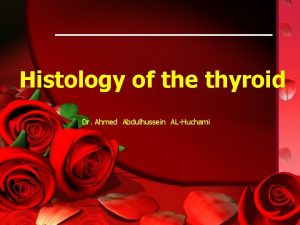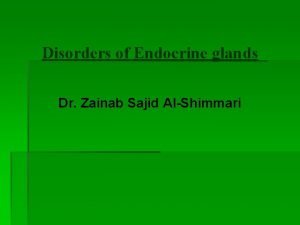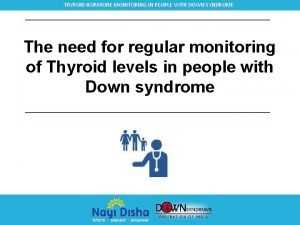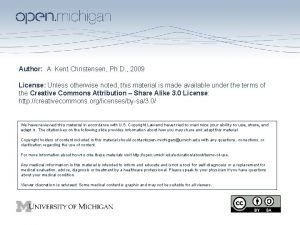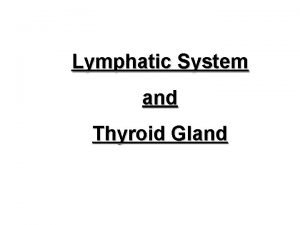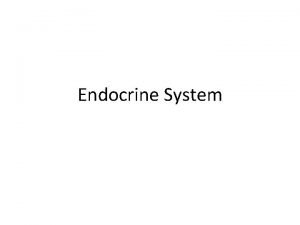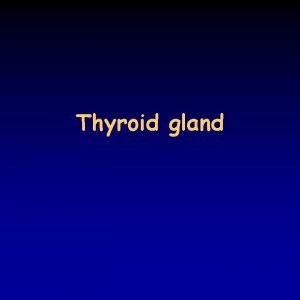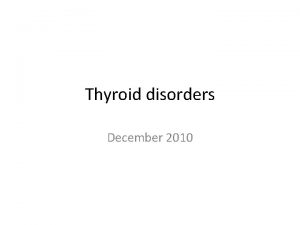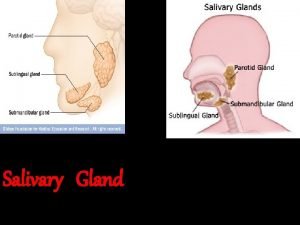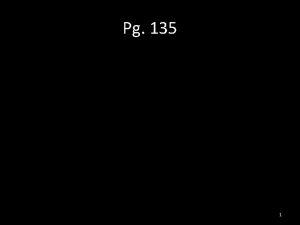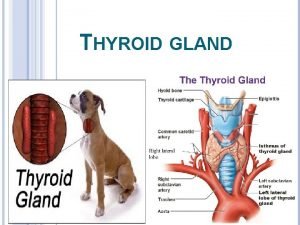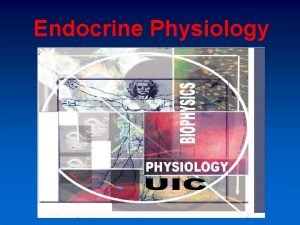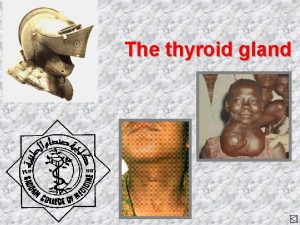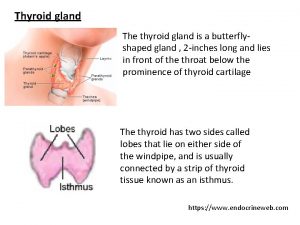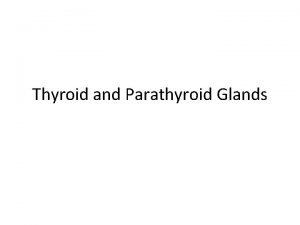Thyroid Gland Thyroid Gland The thyroid gland is
















- Slides: 16

Thyroid Gland

Thyroid Gland The thyroid gland is a butterfly shaped gland located immediately below the larynx on each side of and anterior to the trachea, it is one of the largest endocrine glands, normally weighing 15 to 20 grams in adults. The thyroid secretes two major hormones, thyroxine and triiodothyronine, commonly called T 4 and T 3, respectively. Both of these hormones profoundly increase the metabolic rate of the body. The thyroid gland also secretes calcitonin, a hormone involved in calcium metabolism.

Thyroid hormone is Produced in Follicular cells precursor to thyroid hormones (T 3, T 4). Parafollicular cells= Secrete calcitonin, a hormone that is involved with calcium homeostasis, Calcitonin a thyroid hormone that tends to lower the level of calcium in the blood plasma and inhibit reabsorption of bone by action of Parathyroid gland.

1. Divided into 2 lobes, each lobe is divided into lobules, which contains 20 - 40 round to oval follicles, each 50 - 500 microns, with a single layer of cuboidal to low columnar epithelium 2. Lumen contains colloid, which is scalloped and pale in follicles with active secretory activity, densely eosinophilic in inactive follicles and more flocculent ("like a clump or tuft of wool") and basophilic in elderly 3. Stroma contains C cells, formerly called parafollicular cells (actually are intrafollicular), derived from neural crest 4. C cells represent 0. 1% of gland, produce calcitonin, are present in middle and upper third of lateral lobes along central axes, are not present in extreme upper and lower poles or in isthmus Usually 10 C cells per low power field in adults 5. C cells are more numerous in neonates, decrease in adults, increase and appear as nodular aggregates after age 60 years C cells have pale / clear cytoplasm, oval nuclei, difficult to identify with H&E, use calcitonin stain.

6. The major constituent of colloid is the large glycoprotein , which contains the thyroid hormones. 7. Once the secretion has entered the follicles, it must be absorbed back through the follicular epithelium into the blood before it can function in the body. 8. The thyroid gland has a blood flow about five times the weight of the gland each minute, which is a blood supply as great as that of any other area of the body.


SYNTHESIS AND SECRETION OF THE THYROID METABOLIC HORMONES About percent of the metabolically active hormones secreted by the thyroid gland is thyroxine, and percent is triiodothyronine. However, almost all the thyroxine is eventually converted to triiodothyronine in the tissues, so both are functionally important. The functions of these two hormones are qualitatively the same, but they differ in rapidity and intensity of action. Triiodothyronine is about times as potent as thyroxine, but it is present in the blood in much smaller quantities and persists for a much shorter time compared with thyroxine. To form normal quantities of thyroxine, about 50 milligrams of ingested iodine in the form of iodides are required each year, or about 1 mg/week.




EFFECTS OF THYROID HORMONE ON SPECIFIC BODY FUNCTIONS 1. 2. 3. 4. 5. 6. 7. 8. 9. 10. 11. 12. Stimulation of Carbohydrate Metabolism. Stimulation of Fat Metabolism. Effect on Plasma and Liver Fats. Increased Requirement for Vitamins Increased Basal Metabolic Rate Decreased Body Weight Increased Blood Flow and Cardiac Output Increased Heart Rate Increased Heart Strength Normal Arterial Pressure Increased Respiration Increased Gastrointestinal Motility

14. Excitatory Effects on the Central Nervous System. 15. Effect on the Function of the Muscles. 16. Muscle Tremor. 17. Effect on Sleep. 18. Effect on Other Endocrine Glands. 19. Effect of Thyroid Hormone on Sexual Function.

REGULATION OF THYROID HORMONE SECRETION To maintain normal levels of metabolic activity in the body, precisely the right amount of thyroid hormone must be secreted at all times; to achieve this ideal level of secretion, specific feedback mechanisms operate through the hypothalamus and anterior pituitary gland to control the rate of thyroid secretion.

FEEDBACK EFFECT OF THYROID HORMONE TO DECREASE ANTERIOR PITUITARY SECRETION OF TSH Increased thyroid hormone in the body fluids decreases secretion of TSH by the anterior pituitary. When the rate of thyroid hormone secretion rises to about 1. 75 times normal, the rate of TSH secretion falls essentially to zero. Almost all this feedback depressant effect occurs even when the anterior pituitary has been separated from the hypothalamus. Therefore, it is probable that increased thyroid hormone inhibits anterior pituitary secretion of TSH mainly by a direct effect on the anterior pituitary gland itself. Regardless of the mechanism of the feedback, its effect is to maintain an almost constant concentration of free thyroid hormones in the circulating body fluids.


 Dog thyroid gland
Dog thyroid gland Thyroid parafollicular cells
Thyroid parafollicular cells Follicular adenoma
Follicular adenoma Oxyphil
Oxyphil Parathyroid gland innervation
Parathyroid gland innervation Four oval masses on posterior thyroid gland
Four oval masses on posterior thyroid gland Hypothyroidism dwarfism
Hypothyroidism dwarfism Cushing syndrome
Cushing syndrome Hashitoxicosis
Hashitoxicosis Microanatomy of thyroid gland
Microanatomy of thyroid gland Parathyroid gland chief cell
Parathyroid gland chief cell Nodular goiter
Nodular goiter Enlarged thyroid
Enlarged thyroid Follicular cells of thyroid gland
Follicular cells of thyroid gland Lymph node
Lymph node Thyroid and parathyroid glands
Thyroid and parathyroid glands Myxödem
Myxödem
